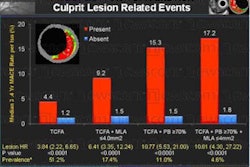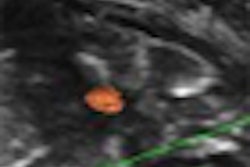Morphology criteria on ultrasound can be used to determine if cancer has metastasized in melanoma patients and, if so, how much it has spread, according to results presented this week at the European Cancer Organization (ECCO) and the European Society for Medical Oncology (ESMO) meeting in Berlin.
Presenter Dr. Christiane Voit of Charité Medical University in Berlin, along with colleagues in Germany and the Netherlands, found the presence of peripheral perfusion to be an early sign of lymph node metastasis, indicating low tumor load and a low hazard ratio. On the other hand, identification of a balloon-shaped pattern and/or loss of central echoes are late signs of metastasis, reflecting high tumor load and a high hazard ratio, according to the researchers.
"With these criteria, we can identify any amount of [sentinel lymph node] tumor burden correctly prior to the surgical SN procedure in 75%-90% of cases," wrote the authors in the study abstract. "[Balloon-shaped lymph node and/or loss of central echoes and peripheral perfusion] are independent prognostic factors for survival."
The study team prospectively evaluated 850 consecutive patients who underwent lymphoscintigraphy and ultrasound prior to sentinel lymph node biopsy. The ultrasound images were scored for six morphologic criteria, including the presence of peripheral perfusion, loss of central echoes, balloon-shaped lymph node, hump structure, echo-poor islands, and cap structure.
Fine-needle aspiration cytology was performed in all suspicious ultrasound cases. Findings were compared with the gold standard of final sentinel lymph node biopsy.
The researchers found that the presence of peripheral perfusion and/or balloon-shaped lymph node and/or loss of central echoes raised the sensitivity of ultrasound to greater than 80%, with 80% specificity, 52% positive predictive value, and 94% negative predictive value (p < 0.001). Overall survival was 93% for patients with none of these characteristics, 87% for patients with the presence of peripheral perfusion, and 56% for balloon-shaped lymph node/loss of central echoes (with or without the presence of peripheral perfusion).
The study results now need to be confirmed in multicenter clinical trials, said Voit, who is a dermatologist and head of the diagnostic unit at the university's Skin Cancer Centre.
Related Reading
Noncontrast CT with PET reduces melanoma radiation dose, August 12, 2009
Melanogenesis inhibition sensitizes melanoma cells to radiotherapy, October 6, 2008
Radioimmunotherapy targets metastatic melanoma lesions in phase I trial, July 2, 2008
Stereotactic radiosurgery improves survival after melanoma brain metastases, May 24, 2007
Copyright © 2009 AuntMinnie.com



















